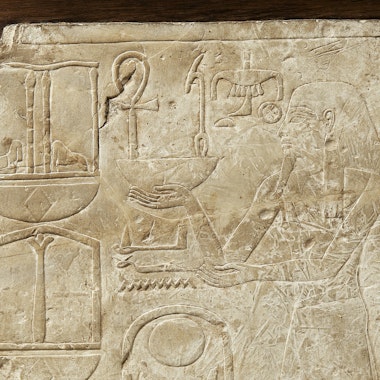Egyptian. Relief of Amenhotep I, 1539–1292 BCE. A303. Public Domain.
From Thebes to Philadelphia: Tracing the Provenance of an Egyptian Relief
By Carl Walsh, Postdoctoral Research Fellow
May 2021
Uncovering the provenance, or ownership history, of Egyptian objects in museum collections can be particularly challenging. Ancient objects can find their way into museums through a variety of routes, including archaeological excavation, purchase on the antiquities market, private gifting or donation, and looting. In many cases, it’s a combination thereof. Reconstructing an object’s history involves poring through old collection catalogues and archival documents such as bills of sale, dealer correspondence, and excavation reports.
Some objects, however, have no provenance record. Many museums acquired their Egyptian objects in the 19th and early 20th centuries and often received no official documentation of where they came from. Archaeologists at the time did not always publish all the material they excavated, so gifts and donations from these projects to museums and private collectors frequently came with little contextual information on their findspots. When this information is lost, tracing an artifact to its source is extremely difficult. Occasionally, though, researchers happen upon a document, photograph, or drawing that can help to piece together a fractured history. Just such a chance discovery allowed us to trace an Egyptian relief in the Barnes collection back to its original context in an Egyptian temple and to uncover more details of the object’s history.
Reconstructing the Relief
The object in question is a limestone relief (A303, fig. 1a) that can be found in the east wall ensemble of Room 16 (Fig. 1b). Placed low near the doorway of Room 17, the object is easy to overlook. The uniform beige color of the limestone and its delicate, shallow relief do not immediately catch the eye like the medieval and Islamic manuscripts and the paintings by Marsden Hartley and Charles Prendergast that surround it.
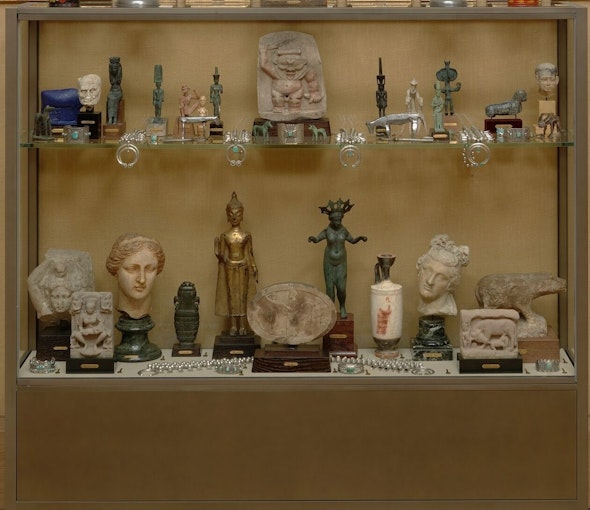
Figure 1b: Relief of Amenhotep I (A303) in the Barnes Foundation (lower right)
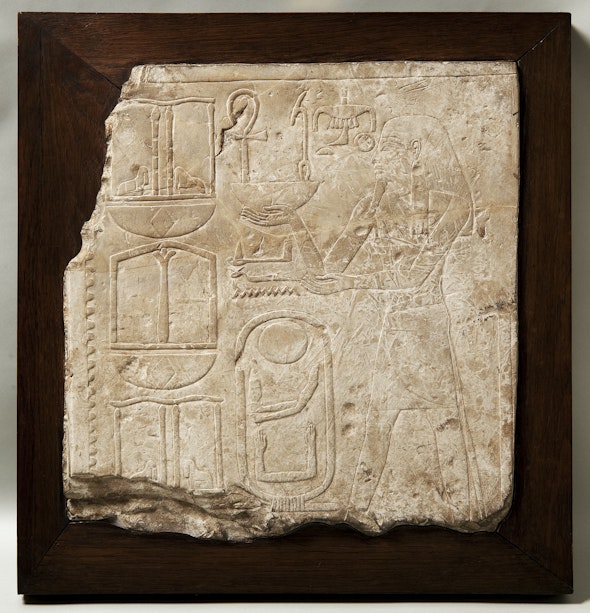
Figure 1a: Egyptian. Relief of Amenhotep I, 1539–1292 BCE. A303. Public Domain.

Figure 1c: Digitally inked drawing of the relief (drawing by author)
The relief’s iconography is difficult to understand without a detailed knowledge of Egyptian art and language. It depicts a jubilee festival celebrating 30 years of the reign of the early New Kingdom pharaoh Amenhotep I (1525–1504 BCE). On the right, a bearded god is pictured with a broad collar, linen garment, and a bull’s tail—traditional royal regalia meant to harness the power of the bull (Fig. 1d). The hieroglyphs next to his face name the ancient city of Nubt, marking him as its patron god. He holds a basket in the shape of the hieroglyph neb (all), which contains the signs ankh (life) and was (power). These words are part of an inscription that continues under the god’s hands and ends with an oval cartouche (an ornamental motif surrounding a royal name). It reads: He gives all life and dominion to Djeser-Kha-Re (Amenhotep I). “He” here refers to the god, who is performing the described act of giving the signs “all life and dominion” to the king.
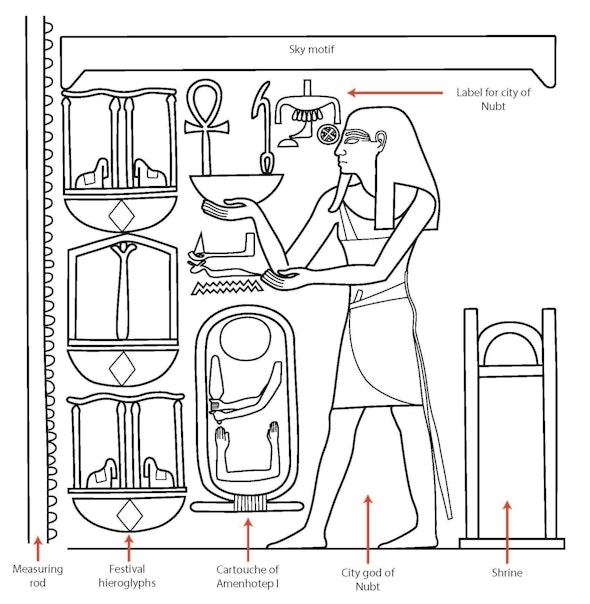
Figure 1d: Reconstructed elements of the scene (drawing by author)
To the left of this vertical inscription are three hieroglyphs for festivals, which take the form of stylized architectural representations of festival shrines. Looking closely, a tent canopy can be seen with two cushioned thrones inside, where the king would be seated (Fig 2a). The sign in the middle names the particular festival, the Heb Sed (Fig. 2b). The renewed years of the king’s reign are referenced on the scene’s far left through a notched measuring stick—also the hieroglyph renpet (year)—which continues off the top and bottom of the relief (Fig. 1c). Other partially missing elements include a low-relief sky motif and a small shrine behind the god (see fig. 1c). These elements indicate that the relief was originally part of a much larger scene, as discussed below.
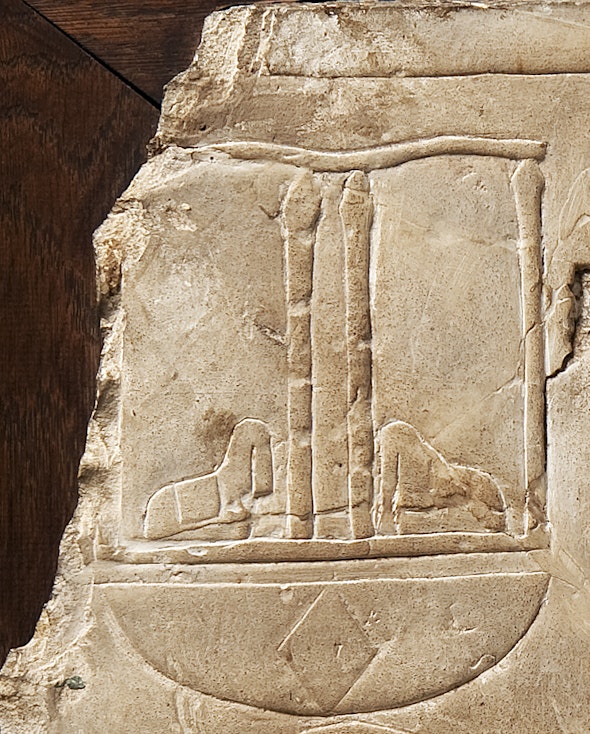
Figure 2a: Festival sign with thrones
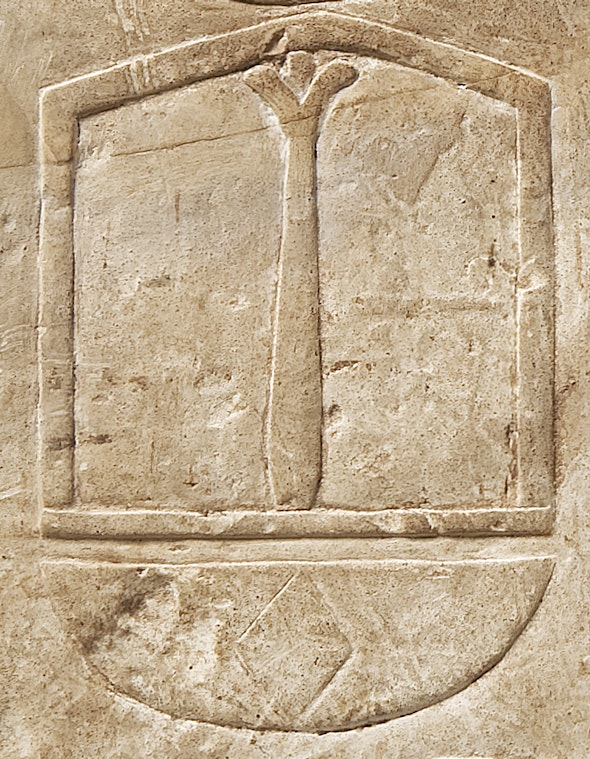
Figure 2b: Heb Sed festival sign
This type of scene depicting the Heb Sed festival originated in the Early Dynastic Period (3100–2686 BCE). However, the Barnes relief has close parallels with scenes from royal temple door ornamentation dating to the later Middle Kingdom (2025–1700 BCE). For example, the Heb Sed lintel (a horizontal architectural piece spanning a doorway) of the Middle Kingdom pharaoh Senwosret III, found at Medamud, near modern Luxor, depicts the king seated on a throne within a festival shrine and wearing the white crown of Upper Egypt (on the right) and the red crown of Lower Egypt (on the left) (Fig. 3). He receives a measuring rod (representing continued years to his reign) from regional versions of the god of chaos, Seth, and the falcon god of kingship, Horus, who take the form of heraldic standards. The far right and left registers contain various city gods, who each stand before a small shrine. The total scene pays homage to the king, symbolizing his rulership over a united Egyptian kingdom. Was the Barnes relief part of a similar scene, and if so, to what monument did it belong in Egypt?
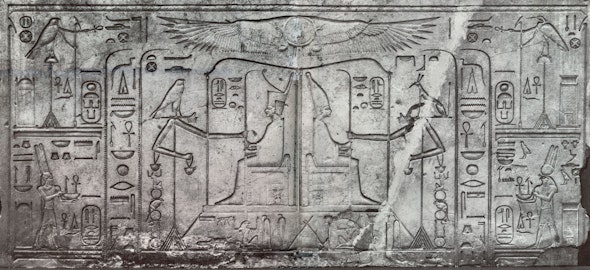
Figure 3: Lintel of Senwosret III, Middle Kingdom. Cairo Museum
Tracing and Reconstructing the Barnes Relief
Amenhotep I came from a prominent family based in Thebes (modern Luxor). His popularity in his hometown led to his deification as a local god after his death, along with his mother, Ahmose-Nefertari. Both were celebrated in annual festivals, worshipped in temples and shrines, and even depicted in local tombs as funerary gods.¹ Amenhotep I’s strong association with Thebes suggests that the Barnes relief came from this area. The carving style and proportions also suggest that it belonged to a monument to this king or perhaps one of his immediate successors. However, very few structures built by Amenhotep I survive in Thebes, making it difficult to place this relief in a particular monument.
A breakthrough came when Jennifer Houser Wegner, associate curator at the Penn Museum, noticed that the Barnes relief was nearly identical in style and iconography to relief fragments discovered in 1896 and published in 1898 by the Egyptologist Wilhelm Spiegelberg.² The fragments were found in a curious temple built by and dedicated to Amenhotep I and Ahmose-Nefertari on the west bank of Thebes (Fig. 4). Spiegelberg’s report indicates that the temple was poorly preserved, and very little is known about it even today. The temple may have been named Meniset, according to some inscribed objects found there. Spiegelberg’s report also included photographs of a series of squeezes (a type of paper impression) and line drawings of relief fragments from the temple.³ One of these squeezes shows a scene identical to the Barnes relief, with areas of damage that exactly match (Fig. 5). This is clearly the same fragment, which had been later recut into a more symmetrical square shape.

Figure 4: Plan of the surviving features of the Meniset temple drawn by Howard Carter, 1917
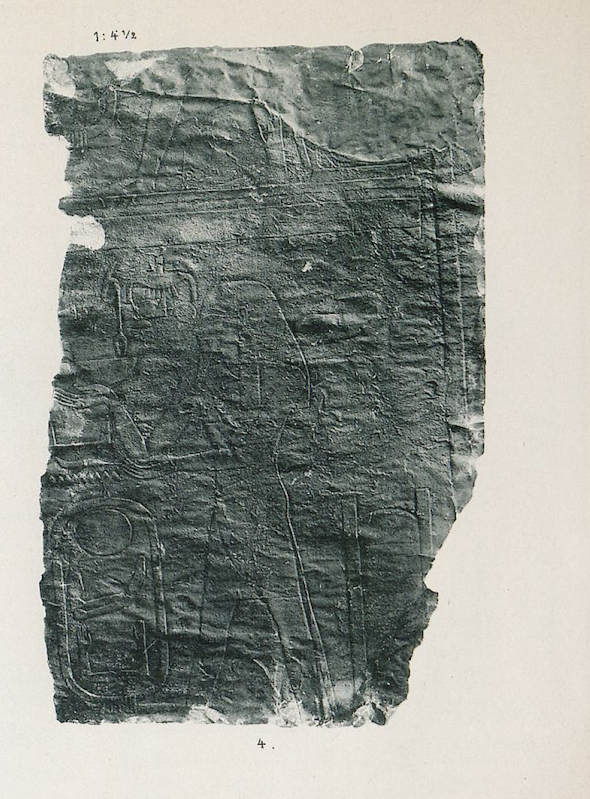
Figure 5: Squeeze of a fragment found by Spiegelberg at the Meniset temple. Spiegelberg, 1898
In the early 20th century, the Egyptologist Kurt Sethe used Spiegelberg’s images to reconstruct the scene (Fig. 6) as a lintel very similar to that of Senwosret III’s, with a mirror image of Amenhotep I seated on a throne under a festival hall. The king wears the crowns of Lower Egypt⁴ (right side) and Upper Egypt (left side) and is surmounted by a winged sun disk. Before him, Horus and Seth present a measuring rod representing the continuing years of his reign. Behind them are mirrored columns of hieroglyphic text that describe offerings of life and power to the king. On vertical registers, city gods standing before shrines present their offerings to the king.⁵ These images likely continued down the doorjambs, as seen in the example of Senwosret III, and would have been plastered white and brightly painted. The Barnes piece would likely have been placed on the bottom right corner of the lintel, as part of the vertical register of gods.
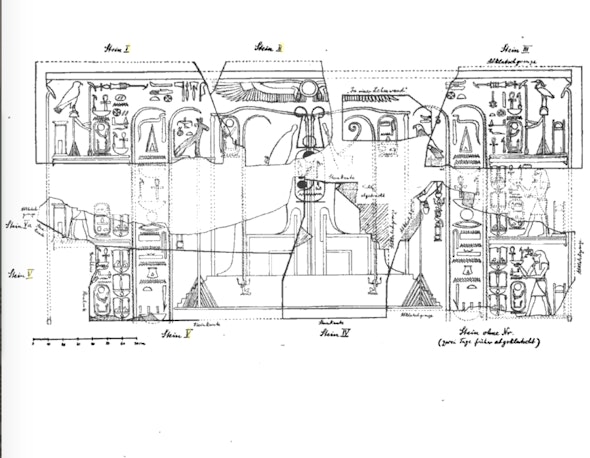
Figure 6: Reconstruction of the Amenhotep I lintel by Sethe, 1921
From Thebes to Philadelphia
Spiegelberg makes no mention of the fragment’s removal in his notes, and it seems that he left the majority of the surviving fragments at the site.⁶ Some small fragments were likely taken back to Strasbourg, France, by Spiegelberg in 1911 and to Berlin by the Egyptologist Georg Möller after his excavation of the temple in the same year.⁷ Other excavations and clearances of the temple by Howard Carter (1914) and Clarence Fisher (1921) make no mention of the festival reliefs.
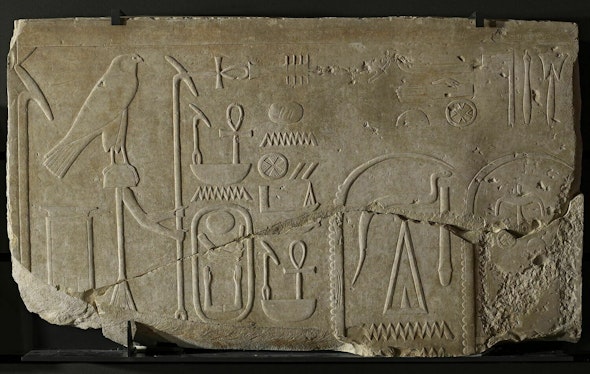
Figure 8: Relief fragment from the Amenhotep I lintel. Louvre, Paris
The temple was probably looted sometime after Spiegelberg’s excavations, as some of the festival reliefs made their way onto the antiquities market in Cairo.⁸ In a December 1896 letter to his friend and colleague Perry Newberry (who helped excavate the temple), Spiegelberg wrote that the site was reportedly attracting robbers.⁹ In addition, Kurt Sethe noted that Spiegelberg had mentioned seeing two of the festival reliefs in the collection of a Cairo antiquities dealer named Nahman in 1911.¹⁰ This was likely Maurice Nahman, a well-known dealer who sold Egyptian antiquities to major museums and collections in Europe and North America.¹¹ Indeed, one of these fragments is likely now in the Louvre, having been purchased from Nahman in 1912.¹² The Barnes fragment could possibly be the other fragment Spiegelberg saw at Nahman’s gallery.

Figure 9a: Albert C. Barnes. Manolakos purchase list [Paul Guillaume], undated. Albert C. Barnes Correspondence, Barnes Foundation Archives

Figure 9b: Albert C. Barnes. Manolakos purchase list [Paul Guillaume], undated. Albert C. Barnes Correspondence, Barnes Foundation Archives
It is unclear how Albert Barnes acquired the Amenhotep I relief. He bought most of the Egyptian objects in his collection from a Greek art dealer named George Manolakos in Paris, December 1923.¹³ The record of the sale, in Barnes’s handwriting, details a number of objects but only two reliefs (Fig. 9). One is listed as “polychrome” and the other as a “primitive bas relief.” The relief in question is not painted, so it cannot be the first one, and the well-executed carving does not match the description of “primitive.” However, this description could have been Barnes’s opinion or related to the concept of primitivism, in which he framed much of the ancient and ethnographic art in his collection. Still, other objects in the collection better fit this description, such as an Old Kingdom door lintel with an inscription carved in raised relief (A161). If this is the case, the Amenhotep I relief may have been acquired through an unknown dealer or, perhaps, an undocumented purchase from Manolakos.
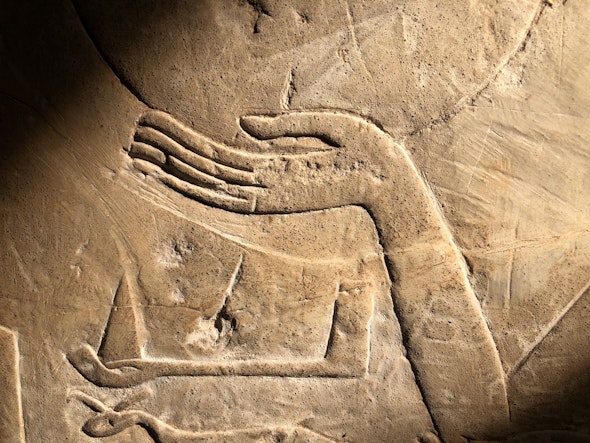
Figure 10: Detail from the Barnes fragment with visible break lines, as well as signs of restoration and repair (photo by author)
The mystery of how this fragment came to be in Barnes’s possession is yet to be solved, and is intertwined with the lingering questions of what happened to the other relief fragments from the temple. However, the object’s physical condition gives more clues about its provenance. Cut and chisel marks on its sides and back indicate that the relief was indeed recut, perhaps to make it more portable and easily framed for sale. X-radiography has revealed that the relief was at some point broken into at least three pieces, perhaps a result of its removal or recutting, and then restored using some kind of adhesive and filler (Fig. 10). In addition, potential signs of cleaning on the surface, indicated by the slight dissolution of the limestone, are noticeable on the bottom part of the relief, where fossil remains are exposed (see Fig. 1a, around the figure of the god). The restoration suggests the work of a professional restorer in the late 19th or early 20th century and points to a likely period of ownership in a private collection or museum. The relief must have been subsequently sold by that owner and found its way onto the art market for Barnes to purchase at a yet undetermined time.
Where Do We Go from Here?
Research on this relief is ongoing, and through continued technical examination and archival study, more of its provenance may be pieced together. Understanding more about this fragment and the Meniset temple is important, as the structure today is almost completely inaccessible. Already poorly preserved in the early 20th century, it has undergone further damage since being used as a refuse mound for an alabaster factory. Little opportunity may remain for re-excavation, making archival and museum collection research vital in learning more about this temple and its history.
Endnotes
¹ Jaroslav Cerny, “Le Culte d’Amenophis I Chez Les Ouvriers de La Nécropole Thébaine,” Bulletin de l’Institut Français d’Archéologie Orientale 27 (1927): 159–203.
² Wilhelm Spiegelberg, Zwei Beiträge Zur Geschichte Und Topographie Der Thebanischen Necropolis Im Neuen Reich: I. Der Grabtempel Amenophis’ I. Zu Drah-Abu’l-Negga. II. Plan Einer Gesamtarbeit Über Die Verwaltung Der Thebanischen Necropolis Im Neuen Reich. (Vortrag.) (Schlesier & Schweikhardt, 1898).
³ Spiegelberg.
⁴ Lower Egypt is the region from where the Nile delta meets the Mediterranean to just south of modern Cairo. Upper Egypt refers to the region south of this to the area of Aswan, just north of the border with modern Sudan.
⁵ Kurt Sethe, “Note,” Göttingische Gelehrte Anzeigen 164 (1902): 29–32; H. E. Winlock, “A Restoration of the Reliefs from the Mortuary Temple of Amenhotep I,” The Journal of Egyptian Archaeology 4, no. 1 (1917): 11–15.
⁶ By the time the German archaeologist Georg Möller excavated the temple in 1911 some of the remaining stone walls and reliefs had been removed. Rudolf Anthes, “Die Deutschen Grabungen Auf Der Westseite von Theben in Den Jahren 1911 Und 1913,” Mitteilungen Des Deutschen Instituts Für Ägyptische Altertumskunde in Kairo 12 (1943): 1–68.
⁷ My thanks to Dr. Caris-Beatrice Arnst of the Ägyptisches Museum und Papyrussammlung in Berlin for sharing the museum records of these fragments. See also Charles Cornell van Siclen, “The Temple of Meniset at Thebes,” Serapis 6 (1980): 183–207; Phillipe Derchain, “Débris Du Temple-Reposoir d’Amenhotep Ier et d’Ahmès Nefertari à Dra’ Abou’l Naga’,” Kémi 19 (1969): 17–21; Sethe, “Das Jubiläumsbild Aus Dem Totentempel Amenophis I.”
⁸ Anthes, “Die Deutschen Grabungen Auf Der Westseite von Theben in Den Jahren 1911 Und 1913.”
⁹ Richard Spiegelberg, Wilhelm Spiegelberg - A Life in Egyptology (Chicago: Oriental Institute of University of Chicago, 2015).
¹⁰ Sethe, “Das Jubiläumsbild Aus Dem Totentempel Amenophis I.”
¹¹ Nahman’s guestbook, now in the Brooklyn museum, contains the signatures of many well-known Egyptologists, museum curators, and antiquities dealers. It can be viewed online at the Brooklyn Museum here.
¹² Elisabeth Delange, Reliefs Égyptiens Du Nouvel Empire (Paris: KHEOPS, 2019). The relief can be viewed on the Louvre’s new online collection.
¹³ Albert C. Barnes. Manolakos purchase list [Paul Guillaume], undated. Albert C. Barnes Correspondence, Barnes Foundation Archives.
